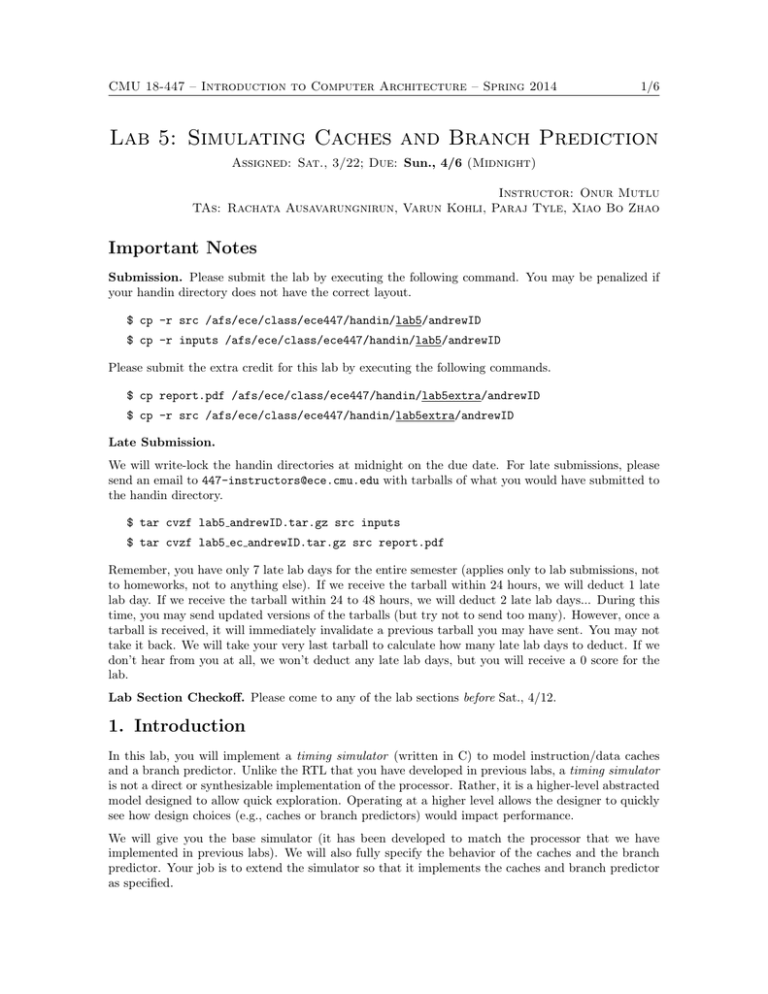Lab 5: Simulating Caches and Branch Prediction
advertisement

CMU 18-447 – Introduction to Computer Architecture – Spring 2014 1/6 Lab 5: Simulating Caches and Branch Prediction Assigned: Sat., 3/22; Due: Sun., 4/6 (Midnight) Instructor: Onur Mutlu TAs: Rachata Ausavarungnirun, Varun Kohli, Paraj Tyle, Xiao Bo Zhao Important Notes Submission. Please submit the lab by executing the following command. You may be penalized if your handin directory does not have the correct layout. $ cp -r src /afs/ece/class/ece447/handin/lab5/andrewID $ cp -r inputs /afs/ece/class/ece447/handin/lab5/andrewID Please submit the extra credit for this lab by executing the following commands. $ cp report.pdf /afs/ece/class/ece447/handin/lab5extra/andrewID $ cp -r src /afs/ece/class/ece447/handin/lab5extra/andrewID Late Submission. We will write-lock the handin directories at midnight on the due date. For late submissions, please send an email to 447-instructors@ece.cmu.edu with tarballs of what you would have submitted to the handin directory. $ tar cvzf lab5 andrewID.tar.gz src inputs $ tar cvzf lab5 ec andrewID.tar.gz src report.pdf Remember, you have only 7 late lab days for the entire semester (applies only to lab submissions, not to homeworks, not to anything else). If we receive the tarball within 24 hours, we will deduct 1 late lab day. If we receive the tarball within 24 to 48 hours, we will deduct 2 late lab days... During this time, you may send updated versions of the tarballs (but try not to send too many). However, once a tarball is received, it will immediately invalidate a previous tarball you may have sent. You may not take it back. We will take your very last tarball to calculate how many late lab days to deduct. If we don’t hear from you at all, we won’t deduct any late lab days, but you will receive a 0 score for the lab. Lab Section Checkoff. Please come to any of the lab sections before Sat., 4/12. 1. Introduction In this lab, you will implement a timing simulator (written in C) to model instruction/data caches and a branch predictor. Unlike the RTL that you have developed in previous labs, a timing simulator is not a direct or synthesizable implementation of the processor. Rather, it is a higher-level abstracted model designed to allow quick exploration. Operating at a higher level allows the designer to quickly see how design choices (e.g., caches or branch predictors) would impact performance. We will give you the base simulator (it has been developed to match the processor that we have implemented in previous labs). We will also fully specify the behavior of the caches and the branch predictor. Your job is to extend the simulator so that it implements the caches and branch predictor as specified. CMU 18-447 – Introduction to Computer Architecture – Spring 2014 2/6 2. Timing Simulator Unlike in previous labs, where we built our pipeline in Verilog, we are not constrained to logic-level implementation in a C-based timing simulator. Our only goal is to compute the number of cycles a program execution would take on the simulated processor. Because of this, many simplifications are possible. We do not actually need to model control logic and datapath details in each block of the processor; we only need to write code for each stage that performs the relatively high-level function of that pipeline stage (read the register file, access memory, etc.). In general, the simulator’s algorithms and structures do not need to exactly match the processor’s algorithms and structures, as long as the result is the same. While we no longer have a low-level implementation, and thus cannot determine the critical path (or other cost metrics that we care about, such as area taken on a silicon chip, or power consumed during operation), we know how well the processor would perform. 3. Microarchitectural Specifications Your goal is to implement the timing simulator so that it models an ARM machine with (i) instruction/data caches, and (ii) a branch predictor. In the following, we will fully specify the microarchitecture of the ARM machine that you will simulate. 3.1. Instruction Cache The instruction cache is accessed every cycle by the fetch stage. Organization. It is a four-way set-associative cache that is 8 KB in size with 32 byte blocks (this implies that the cache has 64 sets). When accessing the cache, the set index is calculated using bits [10:5] of the PC. Miss Timing. When the fetch stage misses in the instruction cache, the block must be retrieved from main memory. An access to main memory takes 50 cycles. On the 50th cycle, the new block is inserted into the cache. In total, an instruction cache miss stalls the pipeline for 50 cycles. Replacement. When a new block is retrieved from main memory, it is inserted into the appropriate set within the instruction cache. If any block within the set are empty, the new block is simply inserted into the empty block. However, if none of the blocks in the set are empty, the new block replaces the least-recently-used block. For both cases, the new block becomes the most-recently-used block. Control-Flow. While the fetch stage is stalled due to a miss in the instruction cache, a control-flow instruction further down the pipeline may redirect the PC. As a result, the pending miss may turn out to be unnecessary: it is retrieving the wrong block from main memory. In this case, the pending miss is canceled: the block that is eventually returned by main memory is not inserted into the cache – even if the redirection happens on the very last stall cycle. Finally, note that a redirection that accesses the same block as a pending miss does not cancel the pending miss. 3.2. Data Cache The data cache is accessed whenever a load or store instruction is in the memory stage. Organization. It is an eight-way set-associative cache that is 64 KB in size with 32 byte blocks (this implies that the cache has 256 sets). When accessing the cache, the set index is calculated using bits [12:5] of the data address that is being loaded/stored. Miss Timing & Replacement. Miss timing and replacement of the data cache are identical to the instruction cache. Handling Stores. Both load and store misses stall the pipeline for 50 cycles. They both retrieve a new block from main memory and insert it into the cache. CMU 18-447 – Introduction to Computer Architecture – Spring 2014 3/6 Dirty Evictions. When a “dirty” block is replaced by a new block from main memory, it must be written back into main memory. For the purpose of this lab, we will assume that such dirty evictions are handled instantaneously – i.e., they are written immediately into main memory in the same cycle as when the new block is inserted into the cache. 3.3. Instruction & Data Caches • Assume that both caches are initially empty. • In both caches, every block has a separate tag that stores information about the block: e.g., address, valid, recency, etc. Tags are initialized to 0. • Assume that the program that runs on the processor never modifies its own code (referred to as self-modifying code): a given block cannot reside in both the caches. • Assume that both caches are initially empty. 3.4. Branch Predictor Organization. The branch predictor consists of (i) a gshare predictor and (ii) a branch target buffer. Gshare. The gshare predictor uses an 8 bit global branch history register (GHR). The most recent branch is stored in the least-significant-bit of the GHR and a value of ‘1’ denotes a taken branch. The predictor XORs the GHR with bits [9:2] of the PC and uses this 8 bit value to index into a 256-entry pattern history table (PHT). Each entry of the PHT is a 2 bit saturating counter that operates as discussed in class: a taken branch increments whereas a not-taken branch decrements; the four values of the counter correspond to strongly not-taken (00), weakly not-taken (01), weakly taken (10), strongly taken (11). Branch Target Buffer. The branch target buffer (BTB) contains 1024 entries indexed by bits [11:2] of the PC. Each entry of the BTB contains (i) an address tag, indicating the full PC; (ii) a valid bit; (iii) a bit indicating whether this branch is unconditional ; and (iv) the target of the branch. Prediction. At every fetch cycle, the predictor indexes into both the BTB and the PHT. If the predictor misses in the BTB (i.e., address tag != PC or valid bit = 0), then the next PC is predicted as PC+4. If the predictor hits in the BTB, then the next PC is predicted as the target supplied by the BTB entry when either of the following two conditions are met: (i) the BTB entry indicates that the branch is unconditional, or (ii) the gshare predictor indicates that the branch should be taken. Otherwise, the next PC is predicted as PC+4. Update. The branch predictor structures are always updated in the execute stage, where all branches are resolved. The update consists of: (i) updating the PHT, which is indexed using the current value of the GHR (ii) updating the GHR, and (iii) updating the BTB. Unconditional branches do not update the PHT or the GHR, but only the BTB (setting the unconditional bit in the corresponding entry. Initial State. All branch predictor structures are initialized to 0. 3.5. Flushing the Pipeline When resolving a branch, the pipeline is flushed under any of the following conditions: • The instruction is a branch, but the predicted direction does not match the actual direction. • The instruction is a branch, and it is taken, but the predicted destination (target) does not match the actual destination • The instruction is a branch, but it was not recognized as a branch (i.e., BTB miss) CMU 18-447 – Introduction to Computer Architecture – Spring 2014 4/6 4. Lab Resources 4.1. Source Code The source code is available at: /afs/ece/class/ece447/labs/lab5. Do NOT modify any files or folders unless explicitly specified in the list below. • Makefile • refsim: Reference simulator in machine-executable format • verify: Script that compares your simulator against the reference simulator • src/: Source code (Modifiable; feel free to add more files) – pipe.c: Your simulator (Modifiable) – pipe.h: Your simulator (Modifiable) – cache.c: Your cache sim (Modifiable) – cache.h: cache sim headers(Modifiable) – bp.c: Your branch predictor (Modifiable) – bp.h: branch predictor headers (Modifiable) – arm.h: ARM related pound defines – shell.c: Interactive shell for your simulator (similar to Lab 1) – shell.h: Interactive shell for your simulator (similar to Lab 1) • 447inputs/: Example test inputs for your simulator • inputs/: Your custom test inputs (Modifiable; feel free to add more files) 4.2. Makefile We provide a Makefile that automates the compilation and verification of your simulator. To compile your simulator: $ make To compile your simulator and verify it against the reference simulator using one or more test inputs: $ make verify INPUT=447inputs/inst/addiu.x $ make verify INPUT=447inputs/inst/*.x $ make verify 5. Getting Started For this lab, you do not need the setup447 script. Please do not source it. If you do, you will get an error due to a incorrectly configured $LD LIBRARY PATH environment variable (as was explained on Piazza). 5.1. The Goal We provide you with a skeleton of the timing simulator that models a five-stage ARM pipeline: pipe.c and pipe.h. As it is, the simulator is already architecturally correct: it can correctly execute any arbitrary ARM program.1 When the simulator detects data dependences, it correctly handles them 1 This is not entirely true since we pose the usual restrictions on system calls, exceptions, etc. CMU 18-447 – Introduction to Computer Architecture – Spring 2014 5/6 by stalling and/or bypassing. When the simulator detects control dependences, it correctly handles them by flushing the pipeline as necessary. N OTE: Please do not edit the given ARM pipeline itself to change its functionality. For example, since the data dependencies are all resolved in the decode stage, changing the forwarding mechanism to forward to any other stage would be changing the pipeline. Look over and understand the starter code before beginning your tasks. By executing the following command, you can see that your simulator (sim) does indeed have identical architectural outputs (e.g., register values) as the reference simulator (refsim) for all the test inputs that we provide in 447inputs/. $ make verify However, your simulator has different microarchitectural outputs (e.g., cycle count) than the reference simulator. Your job is to model the timing effects of the caches, the branch predictor, and main memory so that your simulator becomes microarchitecturally equivalent to the reference simulator. A final note, please do not worry about implementing any instructions who write back to R15 (PC), except for the case mov R15, R14, which stores the linker address as the next PC. 5.2. Studying the Timing Simulator Please study pipe.c and pipe.h in detail. The simulator models each pipeline stage as a separate function – e.g., pipe stage fetch(). The simulator models the state of the pipeline as a collection of pointers to Pipe Op structures (defined in pipe.h). Each Pipe Op represents one instruction in the pipeline by storing all of the necessary information about the instruction that is needed by the simulator. A Pipe Op structure is allocated when an instruction is fetched. It then flows through the pipeline and eventually arrives at the last stage (writeback), where it is deallocated once the instruction completes. To elaborate, each stage receives a Pipe Op from the previous stage, processes the Pipe Op, and passes it down to the next stage. The simulator models pipeline stalls by stopping the flow of Pipe Op structures and pipeline flushes by deallocating the Pipe Op structures at different stages. 5.3. Tip The two major tasks of this lab – implementing caches, and implementing branch prediction – are independent, so you may tackle them in either order. One way to approach this lab is to first write a generic implementation of a set-associative cache, and then plug it into both the fetch stage (instruction cache) and the memory stage (data cache). Once the caches are functional and they also stall the pipeline correctly, you can implement the branch predictor. 6. Extra Credit: Cache Exploration We will offer up to 50% additional credit for this lab (equivalent to 2.5% additional credit for the course) for exploring two different design aspects of the cache. 1. Cache size, block size, associativity: a sweep of cache parameters. You should write a set of benchmarks that use significant amounts of memory (for example: accessing a large array in streaming or random patterns), and run your simulator to find IPC for various cache parameters. Show how changing the associativity, block size, and cache size affect performance. 2. Replacement, insertion: an exploration of cache replacement and/or insertion policies. The cache replacement policy specifies which cache block in a set is replaced when a new block is inserted into the cache. The cache insertion policy specifies where in the list of blocks the new CMU 18-447 – Introduction to Computer Architecture – Spring 2014 6/6 block is placed. Up to now, we have used a replacement policy that evicts (replaces) the leastrecently-used block, and an insertion policy that places new blocks at the most-recently-used position. However, other replacement and insertion policies have been studied, and some have been shown to achieve significantly better performance (fewer cache misses) for certain access patterns [1]. You should experiment with a variety of test programs and optimize the cache replacement/insertion policy. 3. Other. Optionally, you may also choose to experiment with other aspects of the cache. For example, using more sophisticated hashing functions to map cache blocks to cache sets and/or using more than one hashing function. Please write a two-part report (report.pdf) that briefly summarizes (i) your observations on the effect of each cache parameter and (ii) your findings on cache replacement/insertion policies. Your report does not need to be more than one page. Please also submit the version of your simulator (src/) that implements the best performing cache replacement/insertion policies. References [1] Vivek Seshadri, Onur Mutlu, Michael A Kozuch, Todd C Mowry The Evicted-Address Filter: A Unified Mechanism to Address Both Cache Pollution and Thrashing. PACT ’12






